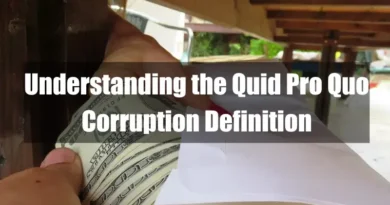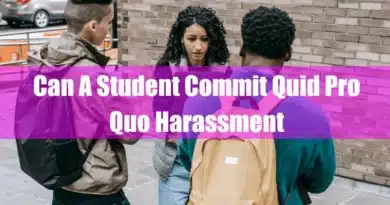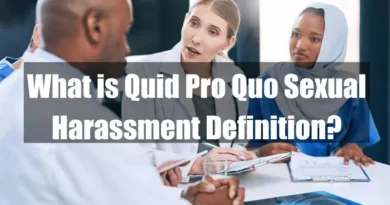I. Defining Domestic Quid Pro Quo Harassment
Domestic Quid Pro Quo Harassment is a form of abuse that occurs when an individual in a position of power within a household exchanges or threatens to exchange something of value, such as love, care, financial support, or housing, in return for sexual favors or other forms of compliance. This type of harassment is typically perpetrated by a spouse, partner, or other cohabiting family member, and it can manifest in various forms, including explicit demands, implied expectations, or coercive control tactics.
II. Distinguishing Domestic Quid Pro Quo Harassment from Other Forms of Harassment
While domestic quid pro quo harassment shares some similarities with other forms of domestic abuse, such as physical violence, emotional abuse, and economic abuse, it is distinguished by the specific element of conditional behavior. In quid pro quo harassment, the abuser seeks to exploit their position of power to gain sexual or other benefits, while in other forms of abuse, the primary goal may be to control, intimidate, or punish the victim.
III. The Scope and Prevalence of Coercive Control in Domestic Violence
Coercive control, a tactic often used in domestic violence, shares similarities with quid pro quo harassment. It involves using power and threats to manipulate a partner into complying with the abuser’s demands. This can include withholding affection, finances, or basic necessities in exchange for desired behavior.
The true prevalence is likely underestimated due to the stigma and power dynamics that often surround domestic abuse.
IV. Understanding Power Dynamics in Households

A. The Role of Power Imbalances in Enabling Domestic Quid Pro Quo Harassment
Power imbalances are central to the dynamics of domestic quid pro quo harassment. Abusers often leverage their position of authority, whether it be based on financial control, social status, or physical strength, to coerce or manipulate victims into complying with their demands. This power imbalance creates an environment where victims feel vulnerable, pressured, and unable to resist the abuser’s advances.
B. Factors Influencing Power Dynamics within Households
Several factors can contribute to power imbalances within households, including:
- Gender Roles and Expectations: Societal norms and expectations often place men in positions of power and women in subordinate roles, perpetuating gender-based power dynamics.
- Economic Dependence: When one partner relies financially on the other, it can create a power imbalance and make them more susceptible to quid pro quo harassment.
- Cultural Norms: Cultural beliefs and practices that emphasize male dominance or promote silence about domestic abuse can further entrench power imbalances and enable abusers.
- Isolation and Social Control: Abusers may isolate victims from their social support networks, further diminishing their power and making them more reliant on the abuser.
C. Identifying Power Structures and Potential Abuses of Power
Recognizing power dynamics within a household is crucial for identifying potential quid pro quo harassment. Signs of power imbalances may include:
- One partner making all major decisions
- One partner controlling finances and resources
- One partner restricts the other’s freedom of movement or communication
- One partner making threats or using intimidation tactics
- One partner dismissing or belittling the other’s opinions or feelings
V. Forms of Domestic Quid Pro Quo Harassment

A. Explicit Quid Pro Quo Harassment
Explicit quid pro quo harassment involves clear and direct demands for sexual favors or other forms of compliance in exchange for something of value. Examples include:
- A husband withholding financial support unless his wife agrees to sexual acts
- A partner threatening to evict their cohabiting partner unless they engage in sexual activity
- A parent withholding affection or love from a child unless they comply with certain demands
B. Implicit Quid Pro Quo Harassment
Implicit quid pro quo harassment involves more subtle and indirect coercion or manipulation. Examples include:
- A partner making suggestive comments or gestures, creating an uncomfortable sexual environment
- A spouse withdrawing emotional support or affection as punishment for non-compliance
- A parent creates a hostile home environment, making the victim feel obligated to comply to restore peace
C. Coercive Control and Patterns of Quid Pro Quo Harassment
Quid pro quo harassment often occurs within a context of coercive control, a pattern of behavior aimed at dominating and controlling a victim. Abusers may use tactics such as isolation, surveillance, humiliation, and intimidation to maintain control and enforce their demands.
VI. Impacts of Domestic Quid Pro Quo Harassment

A. Psychological Impacts on Victims
Victims of domestic quid pro quo harassment often experience severe psychological distress, including:
- Anxiety, depression, and post-traumatic stress disorder (PTSD)
- Feelings of helplessness, shame, and self-blame
- Low self-esteem and loss of self-worth
- Difficulty trusting others and forming healthy relationships
B. Social and Emotional Impacts on Victims
Quid pro quo harassment can have profound social and emotional consequences for victims, leading to:
- Social isolation and withdrawal from friends and family
- Difficulty maintaining healthy relationships with partners, children, and friends
- Emotional detachment and numbness
- Difficulty managing emotions and coping with stress
C. Financial and Economic Impacts on Victims
Abusers may exploit their control over finances to victimize their partners further. Victims may experience:
- Loss of financial independence and control over their resources
- Difficulty accessing necessities, such as food, housing, and healthcare
- Accumulating debt and financial strain
- Barriers to employment and economic opportunities
D. Impact on Family Dynamics and Child Well-being
Domestic quid pro quo harassment can have a devastating impact on family dynamics and child well-being, including:
- Creating a hostile and unsafe home environment for children
- Exposing children to violence, abuse, and unhealthy power dynamics
- Increasing the risk of mental health problems, behavioral issues, and developmental delays in children
- Perpetuating cycles of abuse and violence across generations
VII. Addressing Domestic Quid Pro Quo Harassment

A. Recognizing Signs of Domestic Quid Pro Quo Harassment
Identifying signs of domestic quid pro quo harassment can be challenging, as abusers may be adept at hiding their behavior. However, some red flags may indicate an issue:
- Unequal power dynamics within the household
- Patterns of conditional behavior, where love, care, or financial support is withheld or threatened
- Uncomfortable or inappropriate sexual requests or comments
- Pressure to engage in sexual activity or other forms of compliance
- Feelings of fear, coercion, or obligation to comply with the abuser’s demands
B. Seeking Support and Resources
Victims of domestic quid pro quo harassment should not hesitate to seek support and resources. Many organizations and professionals can provide assistance and guidance, including:
1. Domestic violence hotlines:
These hotlines offer 24/7 support, information, and referrals to resources. You can call or chat online anonymously and confidentially.
Here are some hotlines you can call:
- The National Domestic Violence Hotline: 1-800-799-7233
- The National Sexual Assault Hotline: 1-800-656-HOPE
- The National Teen Dating Abuse Hotline: 1-866-338-1456
- The National Child Abuse Hotline: 1-800-422-4453
- The Rape, Abuse & Incest National Network (RAINN): 1-800-656-HOPE. You can also visit RAINN’s website at https://www.rainn.org/
Some of these hotlines offer services in multiple languages.
2. Local domestic violence shelters:
Shelters provide safe havens for victims of domestic abuse, offering counseling, legal assistance, and other resources. You can find a shelter in your area by visiting the National Coalition Against Domestic Violence (NCADV) website at https://ncadv.org/.
3. Legal assistance:
If you are a victim of domestic quid pro quo harassment, you may also want to contact a lawyer to discuss your legal options. Lawyers can help you obtain a protection order, file for divorce, or press charges against the abuser.
It’s important to note that legal options may vary by location. Consider seeking legal advice in your area for specific guidance
4. Mental health support:
If you are experiencing emotional distress as a result of domestic quid pro quo harassment, you may also want to seek mental health support. A therapist can help you cope with the trauma of abuse and develop healthy coping mechanisms.
VIII. Illustrative Case Studies of Domestic Quid Pro Quo Harassment

Case studies provide valuable insights into the dynamics of domestic quid pro quo harassment. They highlight the various forms this abuse can take, the impact it has on victims, and the challenges in addressing it.
A. Illustrative Case Study 1: A Husband’s Control over Finances
In this case study, a husband threatened to withhold financial support from his wife unless she agreed to sexual acts. He controlled their joint bank account and limited her access to money, making her financially dependent on him. This created a power imbalance that he exploited to coerce her into complying with his demands.
B. Illustrative Case Study 2: A Partner’s Isolation and Manipulation
In this case study, a partner isolated their cohabiting partner from their social support network, making them emotionally reliant on them. The partner then used this isolation to manipulate and control the victim, making veiled threats about their relationship if they did not comply with their sexual demands.
C. Illustrative Case Study 3: A Parent’s Conditional Love
In this case study, a parent withheld affection and love from their child unless they complied with their demands. The child felt pressured to engage in sexual acts to regain their parent’s love and approval, creating a harmful pattern of quid pro quo behavior.
D. Examining the Impact of Domestic Quid Pro Quo Harassment on Victims
These case studies demonstrate the profound impact domestic quid pro quo harassment can have on victims. Victims experience psychological distress, social isolation, financial hardship, and strained relationships. The abuse can leave lasting scars on their emotional well-being and ability to form healthy relationships.
E. Highlighting Challenges in Addressing Domestic Quid Pro Quo Harassment
The case studies also highlight the challenges in addressing domestic quid pro quo harassment. Because of their fear, guilt, or financial reliance on the abuser, victims of abuse may be reluctant to ask for assistance, which makes it more difficult for them to acquire the support they require or to leave the violence. Additionally, societal stigma and underrecognition of this form of abuse can hinder victims’ access to support and justice.
IX. Conclusion
Domestic quid pro quo harassment is a serious form of abuse that exploits power imbalances to coerce victims into sexual favors or other forms of compliance. It can have devastating psychological, social, and financial consequences for victims, and it often occurs within a context of coercive control. Despite its prevalence, domestic quid pro quo harassment remains under-recognized and under-addressed.
By addressing domestic quid pro quo harassment effectively, we can create a society where individuals feel safe, respected, and empowered to live free from violence and abuse. Everyone has the right to autonomy, bodily integrity, and freedom from coercion; our collective responsibility is to uphold these rights for all.
Recognizing the signs of domestic quid pro quo harassment is crucial. Help and resources are available; you don’t have to go through this alone.
X. FAQs
A. How does the concept of intersectionality, considering factors like race, ethnicity, and sexual orientation, influence the dynamics and prevalence of domestic quid pro quo harassment?
The concept of intersectionality, which considers how different aspects of a person’s identity, such as race, ethnicity, and sexual orientation, intersect to create unique experiences of oppression and discrimination, has significant implications for understanding the dynamics and prevalence of domestic quid pro quo harassment.
1. Marginalization and Vulnerability
Individuals from marginalized groups, such as women of color, LGBTQ+ individuals, and immigrants, may face heightened vulnerability to domestic quid pro quo harassment due to factors such as:
People from certain groups, such as women of color, LGBTQ+ individuals, and immigrants, may not have enough money, friends, or family to help them or services that understand their culture, making it harder for them to leave the abuse or get help.
- Cultural norms and silence: Societal norms and expectations within certain cultures may discourage victims from reporting abuse or seeking help, perpetuating cycles of silence.
- Fear of deportation or retaliation: Immigrants, particularly undocumented individuals, may fear deportation or retaliation if they report abuse, making them less likely to seek help.
2. Intersectional Discrimination and Power Dynamics
Intersectional discrimination can exacerbate power imbalances and create unique dynamics in domestic quid pro quo harassment. For instance, a woman of color may face simultaneous abuse based on her gender, race, and ethnicity, making it challenging to isolate and identify the specific form of harassment.
3. Intersectionality and Legal Protections
The intersection of multiple identities can also impact victims’ access to legal protections and justice. For example, LGBTQ+ victims may face discrimination within the legal system or lack access to culturally competent legal representation.
B. In the era of increasing digital communication, how has technology been used to quid pro quo harassment within domestic settings, and what challenges does this pose for identification and intervention?
The rise of digital communication has introduced new avenues for domestic quid pro quo harassment, posing challenges for identification and intervention.
1. Digital Surveillance and Control
Abusers may use digital technologies to monitor their victims’ communication, online activities, and whereabouts, creating a pervasive sense of surveillance and control.
2. Online Harassment and Threats
Abusers may engage in online harassment, sending threatening or abusive messages, posting damaging content online, or creating fake accounts to spread rumors or impersonate the victim.
3. Manipulation and Coercion
Abusers may use technology to manipulate and coerce victims, such as by withholding access to shared accounts or devices, threatening to expose private information online, or pressuring victims to engage in unwanted sexual activity through online communication.
4. Challenges in Identification and Intervention
Digital harassment often occurs in private online spaces, making it difficult for third parties to identify and intervene. Additionally, victims may be hesitant to report digital abuse due to fear of further retaliation or embarrassment.
5. Potential Countermeasures
Despite these challenges, technology can also be used to support victims and prevent domestic quid pro quo harassment. For instance, mobile apps can provide discreet access to resources and support. At the same time, digital literacy training can empower victims to protect their privacy and online safety.










Comments are closed.